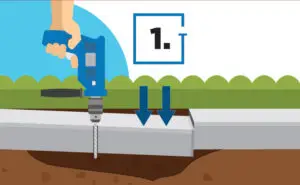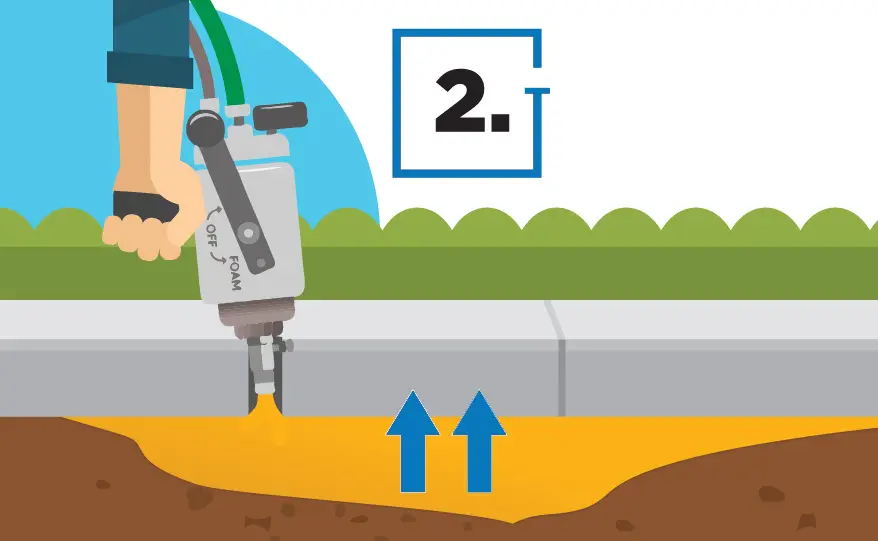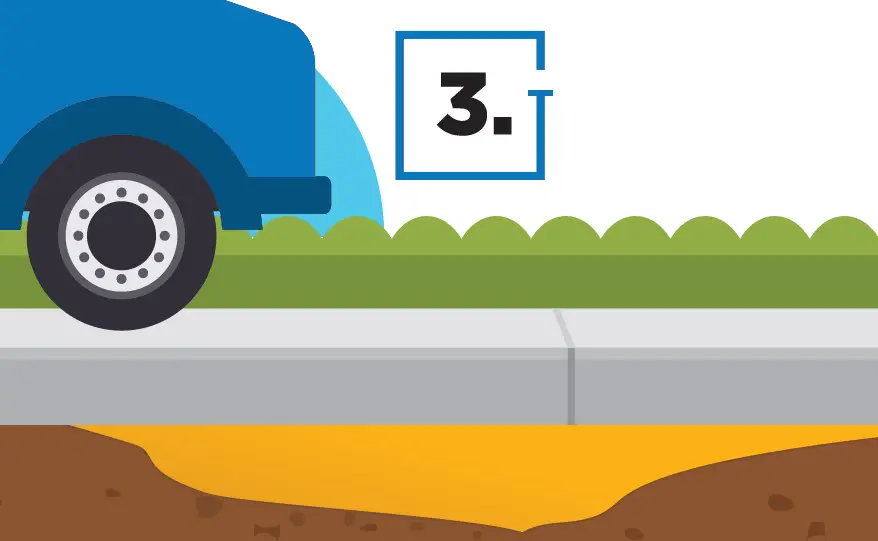Expert Answers To Common Questions
Navigating foundation problems can be challenging, but our team at G.L. Hunt is here to provide the guidance you need! With decades of industry experience, we’re a qualified voice that can answer your foundation and drainage system questions.
Follow along as we explain the answers to some of the frequently asked questions we hear.
Drainage & Gutter FAQs
Gutters play a vital role in protecting your home by channeling rainwater away from the roof and foundation. Without them, water runoff can collect at the base of your home.

Water Runoff Problems
- Soil erosion around the perimeter
- Cracks or weakening of the foundation
- Basement or crawl space flooding
- Damage to landscaping and walkways
- Mold or mildew growth from moisture seepage
Installed just below the edge of the roof, gutters capture rainfall and direct it through a downspout, where it’s released a safe distance away from your home. This system ensures proper drainage, reduces splashback against siding or windows, and prevents water from pooling near your home’s base — which is especially important in areas with expansive clay soil like much of Texas.
By managing rainwater effectively, gutters extend the life of your siding, roofing, and foundation — while also reducing puddles and slippery surfaces around your property.
Gutter maintenance depends on seasonal conditions and your surrounding landscape, but most homeowners should aim to clean their gutters at least twice a year — ideally in spring and fall.
Here’s why those times matter:
- Fall: Leaves, pine needles, and twigs shed from trees and quickly clog gutters, especially after a windy day.
- Spring: Trees bloom and shed debris like seed pods or blossoms, which can also block proper water flow.
In areas with heavy rainstorms, like Texas during spring or early summer, more frequent cleanings may be needed — especially if overhanging trees are near your roof. Signs you may need an extra cleaning include:
- Overflowing water during rain
- Sagging or detached gutters
- Visible plant growth or nesting debris
- Water pooling near the home’s foundation
Routine inspection and cleaning help extend the life of your gutter system and prevent costly water damage.
An exterior drain is an outdoor drainage solution designed to remove excess surface water from your yard, landscaping or paved areas. These systems are commonly seen in areas prone to pooling, such as:
- Near downspouts
- Patios and walkways
- Driveways
- Low-lying lawn areas
Typically, these systems consist of surface-level grates that allow rainwater to enter and flow into a network of underground pipes. From there, the water is directed away from your home and into a designated drainage area like a storm drain, swale or dry well.
Exterior drains help:
- Prevent erosion and standing water
- Protect home foundations from saturation
- Maintain healthy landscaping and lawn conditions
Compared to passive runoff, exterior drains move water away more efficiently, making them a popular choice for properties with poor natural drainage.
A French drain is a highly effective and discreet system used to manage water drainage in yards and around foundations. It’s ideal for homes in Texas, where heavy rains and expansive clay soil can lead to oversaturation and foundation stress.
Here’s how it works:
- A perforated pipe is placed in a sloped trench dug beneath the soil surface.
- The pipe is surrounded by gravel or rock to help water filter down.
- A water-permeable fabric surrounds the system to block soil and debris from entering the pipe.
- As water soaks into the ground, it flows into the pipe and is carried away from the property to a drainage outlet.
French drains are subtle — often covered with sod or decorative gravel — and they prevent standing water, reduce hydrostatic pressure near the foundation, and help keep crawl spaces or basements dry.
Because French drains are buried underground, clogs can be more difficult to detect and fix compared to surface drains. Clogs usually occur due to:
- Soil buildup
- Root intrusion
- Sediment accumulation from unfiltered runoff
Here’s how to address a clog:
- Inspect the outlet end of the drain (often near the edge of the yard or street) to check for visible blockages.
- Use a drain snake or auger to break up any clogs inside the pipe.
- Flush with a hose or pressure washer to help move sediment and debris through the system.
For stubborn or deep clogs, it’s best to contact a professional. At G.L. Hunt, our team uses advanced tools like video inspections and hydro jetting equipment to locate and safely remove clogs — all without damaging your yard or pipe system. Timely maintenance can restore the drain’s performance and protect your property from water damage.
Your home’s foundation depends on consistent, balanced moisture levels in the soil surrounding it. Without proper drainage or functioning gutters, water can pool around the base of your home, leading to serious structural issues. In areas with expansive clay soil — like much of Texas — the risks are even higher.
Here’s why water management matters:
- Excess moisture causes soil to expand, pushing against the foundation and potentially leading to cracks, shifting, or heaving.
- Dry conditions cause the soil to shrink, creating voids under the foundation that can lead to settling.
- Cycles of wet and dry soil put your foundation under constant stress, weakening its structural integrity over time.
Gutters and drainage systems redirect water away from your foundation, maintaining stable soil conditions and preventing erosion, mold growth and long-term foundation damage. They are your first line of defense in preserving your home’s stability and value.
Gutters are meant to protect your foundation — but if they’re clogged, poorly installed or discharging water too close to the house, they can do more harm than good.
Here are warning signs your gutters may be part of the problem:
- Overflowing water during rainstorms
- Downspouts that end near the foundation (within 3 feet of the house)
- Standing water or muddy patches near the base of your home
- Erosion or gullies in flower beds or mulch
- Cracks in the foundation or walls, particularly after heavy rains
- Sagging gutters or detached sections that allow uncontrolled runoff
If you notice these signs, it’s time to inspect and clean your gutters, extend your downspouts or consider a more robust drainage solution. Left unchecked, improper water flow can accelerate foundation deterioration.
Adding soil around your foundation can offer a short-term improvement in grading, but it’s not a substitute for a proper drainage system. Here’s why:
- Soil alone cannot manage heavy rain runoff — without a way to redirect water, it will still accumulate near the foundation.
- Over time, added soil compacts and erodes, especially during Texas storms, leaving your foundation exposed again.
- Without controlling water flow, you risk moisture intrusion, soil expansion and future erosion, even if the slope looks good temporarily.
While regrading is part of a comprehensive water management strategy, it’s most effective when paired with gutters, downspout extensions, French drains or surface drains. The goal isn’t just to move water away — it’s to keep it from returning.
Drainage pipes should always discharge at a safe distance from your foundation and in a location that won’t cause water to flow back toward your home or affect neighboring properties.
Best practices include:
- At least 5–10 feet away from the foundation (more if possible)
- Into storm drains, dry wells or grassy swales that promote safe absorption
- Sloped downward to encourage gravity-assisted water flow
- Never into areas with poor soil absorption or where water will pool and stagnate
In some municipalities, there may be regulations on where and how drainage can be discharged, so it’s important to work with a contractor familiar with local building codes.
At G.L. Hunt, we design custom drainage systems that are both effective and compliant — ensuring that your foundation is protected without compromising your landscaping or local infrastructure.
Fixing drainage and gutters is a crucial step in protecting your foundation, but it may not reverse existing structural damage. Instead, it:
- Stops the root cause of foundation deterioration (excess water and soil movement)
- Prevents further damage from occurring over time
- Improves conditions for additional foundation repairs to last longer
If your foundation has already settled, cracked or shifted, you’ll likely need both:
- Foundation repair (e.g., piers, leveling, crack sealing)
- Drainage and gutter upgrades to prevent recurrence
At G.L. Hunt, we provide comprehensive assessments that look at both structural damage and the underlying moisture issues — offering a full solution to protect your home long term.
You should call a foundation and drainage specialist — not just a landscaper or roofer — when it comes to protecting your foundation. These professionals understand how soil, water and structural systems interact and can design targeted solutions.
Look for companies that:
- Offer foundation and drainage assessments together
- Have experience with Texas-specific soil conditions
- Provide custom solutions like French drains, surface drains, sump pumps and downspout extensions
At G.L. Hunt, our experts specialize in integrated foundation and drainage solutions. We evaluate the full picture — from surface runoff to subsurface water pressure — and tailor repairs to protect your home’s stability, comfort and value.
Crawl Space Repair FAQs

A crawl space is a type of home foundation that creates a shallow, unfinished space between the ground and the floor of your house — usually ranging from one to three feet in height. Unlike basements, crawl spaces aren’t designed for regular human occupancy, but they serve several important functions.
Crawl spaces are commonly found in homes built on pier-and-beam foundations, especially in regions with high moisture levels or expansive clay soil, like Texas.
Advantages Of Crawl Spaces
- Improved ventilation beneath the home
- Easier access to plumbing, HVAC systems, and electrical wiring
- Protection from flooding compared to slab foundations
Common Crawl Space Problems
- 💧 Excess humidity
- 🦠 Mold and mildew growth
- 🪳Pest infestations
- 🏚️ Structural wood damage
A well-maintained crawl space supports your home’s structural integrity, indoor air quality and energy efficiency.
There are several warning signs that may indicate you need crawl space repair — and most of them can be spotted without crawling under your home. These include:
- Musty odors indoors, especially near floors or vents
- Sagging or uneven floors
- Cracks in interior walls, particularly near windows or door frames
- High indoor humidity or condensation on windows
- Increased pest activity, like insects or rodents
- Visible mold or mildew on baseboards or flooring
- Standing water or mud near the foundation
You may also notice rising energy bills, which could point to poor insulation or air leakage from the crawl space. If you suspect an issue, a professional inspection can identify whether it’s due to moisture, structural problems or foundation settling — and whether repairs are needed to protect your home and health.
Texas homes are especially vulnerable to crawl space issues due to a combination of climate and soil conditions. Common causes include:
- Expansive clay soils — Texas soil expands when wet and contracts during droughts, which can cause foundations and piers to shift, leading to structural damage.
- Humidity and rain — Frequent moisture can enter crawl spaces through vents, poorly sealed perimeters or ground vapor, promoting mold, mildew and rot.
- Poor drainage — Inadequate grading, clogged gutters or missing vapor barriers can allow water to collect around and beneath the home.
- Pest intrusion — Open vents or small gaps in your crawl space give easy access to rodents, termites and insects — all of which can damage insulation and structural wood.
- Improper construction or aging — Older homes or poorly built crawl spaces may lack the necessary insulation, sealing or ventilation systems to keep moisture and air under control.
These factors make regular inspection and maintenance critical in Texas. Without intervention, small problems can turn into costly repairs — affecting your home’s structure, comfort and air quality.
Insulating a crawl space requires careful planning and should always begin with a professional assessment of the area’s current condition. The process includes several key steps:
- Inspect and clean the area — Remove all debris, inspect for mold or standing water and address any plumbing leaks or foundation issues.
- Control moisture first — Moisture problems must be solved before insulation. This may involve grading, sump pumps or installing vapor barriers.
- Seal off vents and gaps — Crawl space vents and air gaps can allow outdoor air, pests and moisture inside. Sealing with caulk, spray foam or panels is necessary.
- Choose the right insulation type:
- Rigid foam board is commonly used along foundation walls for its moisture resistance and high R-value.
- Spray foam offers a tight seal and works well around irregular shapes or tight areas.
- Fiberglass insulation, though cheaper, is often discouraged in humid climates due to mold risk
- Install a vapor barrier — If not already present, a vapor barrier should be installed on the floor to prevent moisture from the soil from entering the crawl space.
- Add a dehumidifier — In especially humid climates, a dehumidifier helps regulate moisture levels long-term.
At G.L. Hunt, we specialize in climate-appropriate crawl space insulation designed to improve energy efficiency while protecting your home from moisture-related damage.
Crawl space encapsulation is the process of sealing off the crawl space from outside air and ground moisture to create a clean, controlled environment beneath your home. It is a more advanced and comprehensive solution than simple insulation.
Our encapsulation process involves:
- Clearing and cleaning — We remove any debris, old insulation and standing water from the space.
- Repairs and moisture correction — Addressing issues like wood rot, foundation cracks or mold is essential before sealing.
- Vapor barrier installation — We install a heavy-duty polyethylene vapor barrier across the crawl space floor and up the walls. Seams are tightly sealed to ensure complete coverage.
- Sealing gaps and vents – All exterior vents, gaps and openings are sealed to block out humid air and pests.
- Insulating the walls — Insulation is applied to the crawl space walls to maintain indoor temperature control.
- Adding a drainage system (if needed) — French drains or sump pumps may be installed to manage groundwater.
- Installing a dehumidifier — This helps maintain ideal humidity levels and prevents mold growth.
Encapsulation transforms a damp, musty crawl space into a clean, dry, energy-efficient zone that improves indoor air quality and reduces long-term repair costs.
Crawl space encapsulation is a comprehensive sealing system that protects your home from ground moisture, outside humidity and temperature swings. Unlike basic repairs or insulation, encapsulation provides full environmental control in the crawl space.
Key features of G.L. Hunt’s encapsulation system include:
- A reinforced plastic vapor barrier made of durable polyethylene, professionally applied to the floor, walls and sometimes ceiling
- Air sealing of vents and gaps to stop unwanted airflow and pest entry
- Wall insulation to improve thermal efficiency and reduce energy loss
- Optional sump pumps or drainage mats to manage groundwater
- Dehumidification systems to regulate humidity and prevent mold
Encapsulation not only improves your home’s indoor air quality and energy efficiency but also protects the structural integrity of your foundation.
Mold in your crawl space is a serious issue that can affect your home’s structure and your family’s health. We strongly recommend against DIY mold removal due to the complexity and health risks involved.
Here’s how our experts at G.L. Hunt handle crawl space mold removal:
- Inspection and identification — We perform a thorough inspection to locate mold colonies and identify moisture sources.
- Moisture elimination — Standing water, leaks or high humidity must be addressed before remediation. We fix plumbing issues and improve drainage or ventilation.
- Mold remediation — Using professional-grade antimicrobial treatments and scrubbers, we safely eliminate mold from wood, insulation and other surfaces.
- Encapsulation and prevention — To stop mold from returning, we recommend encapsulating the crawl space and installing a dehumidifier to regulate humidity levels.
By choosing G.L. Hunt, you get long-lasting solutions that treat the root cause — not just the symptoms — of mold problems.
Drying out a damp crawl space is essential to prevent mold, wood rot and pest infestations. G.L. Hunt uses a multi-step process to safely and effectively dry crawl spaces:
- Identify the moisture source — We check for plumbing leaks, drainage issues and ground moisture seeping through walls or floors.
- Remove standing water — If water is present, we use pumps, wet vacuums or drainage systems to remove it quickly.
- Install crawl space fans or ventilation — Temporary air movement can help dry out the space, especially in early remediation stages.
- Deploy industrial-grade dehumidifiers — Our high-capacity dehumidifiers pull excess moisture from the air and maintain healthy humidity levels long-term.
- Use vapor barriers and drainage mats — Prevent future moisture intrusion by sealing the space with a plastic vapor barrier and managing groundwater.
Once dry, we recommend encapsulation and insulation to keep the crawl space moisture-free and energy-efficient.
In most cases, crawl space repair causes minimal disruption to your everyday activities — especially when handled by a professional team with efficient systems in place.
Here’s what you can typically expect:
- Work is performed outside and beneath the home, meaning you won’t have contractors inside your living space.
- You may hear some construction noise or vibration during the day, especially during insulation, encapsulation or structural reinforcement.
- Limited yard access may be required for equipment, materials or trenching — especially for drainage work or foundation pier installation.
- If mold remediation or extensive repairs are involved, temporary relocation may be recommended in rare cases, particularly if there are health concerns.
Our team at G.L. Hunt is committed to respecting your space and minimizing disruption, so you can go about your day with as little interference as possible. We also provide clear timelines and daily progress updates, so there are no surprises.
Yes — crawl space repair and encapsulation can significantly lower your utility bills by improving energy efficiency and eliminating hidden air leaks.
Here’s how:
- Sealing and insulating the crawl space reduces air exchange between the inside and outside of your home, so your HVAC system doesn’t work as hard.
- Moisture control prevents the damp air that makes cooling systems run longer during summer months.
- Encapsulation and dehumidification stabilize indoor air quality and temperature, improving comfort and reducing the energy needed for heating and cooling.
- Repairing ductwork leaks (common in crawl spaces) prevents conditioned air from escaping.
In fact, homeowners in Texas who invest in professional crawl space repairs can see noticeable improvements in monthly utility costs, especially during extreme summer heat or colder winters.
Foundation Repair FAQs
Foundation repair is the process of fixing structural problems in your home’s foundation that can affect safety, stability, and value. Over time, shifting Texas soils, drainage issues, or simple aging can cause cracks, uneven floors and other warning signs that something’s wrong beneath the surface.
How to Know If You Need Foundation Repair
Watch for these common red flags around your home:
- 🧱 Cracks in walls, ceilings, or brickwork
- 🪟 Doors and windows that stick or won’t close properly
- ⌳ Uneven floors or visible gaps where walls meet the floor
- 🏚️ Exterior separation, such as pulling away trim or gaps around windows
These issues often point to underlying soil movement, poor construction practices or long-term water intrusion.
Common Foundation Repair Methods
Depending on the cause and severity, a qualified foundation repair specialist may recommend:
- Underpinning — Strengthens your foundation by extending it deeper into stable soil using concrete or steel piers.
- Piering — Uses steel pipe piles driven into the ground to lift and support sunken sections of the home.
- PolyLevel Foam Injection — A modern method that injects expanding polyurethane foam beneath the slab to lift and level it quickly with minimal disruption.
Each method addresses specific soil and stability issues — and a professional inspection ensures the right solution for your home’s needs.
Why Timely Repairs Matter
Catching foundation issues early can prevent more expensive structural damage, restore your home’s stability, and even improve resale value. At G.L. Hunt Foundation Repair, our team combines experience, advanced technology, and Texas soil expertise to identify problems accurately and deliver lasting results.
Yes, in most cases, homeowners can remain in their house during foundation repair. However, this depends on several factors, such as:
- Scope of the repair – Minor exterior work is less disruptive than full-scale interior structural repairs.
- Type of foundation – Pier-and-beam homes might require more interior access than slab foundations.
- Location of the damage – Repairs under major living spaces, like kitchens or bathrooms, could limit access.
You can expect temporary inconveniences such as:
- Loud construction noise
- Dust and debris in work areas
- Limited access to certain rooms or outdoor areas
Our experienced team prioritizes safety and works efficiently to minimize disruption. If repairs become extensive or involve utilities (like plumbing), temporary relocation may be recommended — but this is rare.
The length of time required for foundation repair can vary significantly depending on:
- Severity of the damage – Minor cracks may be addressed in 1–3 days, while major stabilization projects can take 1–3 weeks.
- Type of repair method – PolyLevel is quicker than pier installation or extensive structural reinforcement.
- Weather conditions – Heavy rain or freezing temperatures can delay work, especially when soil stabilization is involved.
- Accessibility – Tight crawlspaces or densely landscaped yards can require additional labor and time.
Your contractor should provide a clear, personalized project timeline during the initial assessment. At our company, we value transparency and keep homeowners informed at every stage of the repair process.
Buying a house with prior or ongoing foundation repairs isn’t necessarily a deal-breaker — in fact, it can be a sign the current owner has proactively addressed structural concerns. However, due diligence is essential. Consider the following steps:
- Request documentation – Get copies of inspection reports, repair warranties and permits.
- Hire a third-party inspector or structural engineer – An unbiased opinion ensures the repairs were done correctly and safely.
- Understand the extent of the repairs – Cosmetic fixes are different from major structural reinforcements.
- Factor it into negotiations – Repairs may lower the home’s value or require additional monitoring.
If you’re unsure, our team can provide insights or connect you with a local expert to review the foundation repair history before you make a purchase.
In most cases, standard homeowners insurance does not cover foundation repair costs caused by routine settling, soil shifts or natural aging. However, there are exceptions based on the source of the damage. Coverage may apply if the issue stems from:
- A burst pipe or plumbing leak (if sudden and accidental)
- Fire or explosion
- Earthquake or flood (if you carry specific endorsements)
- Storm damage (like fallen trees causing foundation cracks)
To determine if you’re covered:
- Review your policy for exclusions or limitations related to foundation damage.
- Contact your insurance agent for clarification based on the exact cause of damage.
- Consider add-ons like water backup, flood, or earthquake coverage, especially in risk-prone areas.
If your repairs aren’t covered, we offer flexible financing options to help make foundation work more affordable. Reach out to learn more.
Yes, even a severely compromised foundation can often be repaired — but the success and approach depend on the extent of the damage and how early it’s addressed. Modern foundation repair techniques can correct settling, cracking, bowing walls and shifting soil conditions.
Professional contractors use structural assessments to develop a tailored solution, which may involve:
- Underpinning with steel or concrete piers to stabilize and lift the foundation
-
TexJack for pier support in lightweight or limited-access structures
-
Sonotube concrete forms for supporting settled or sunken slabs
Even if your foundation shows serious issues, repairs can often restore both structural integrity and long-term value — but delaying action can make repairs more complex and costly. An expert evaluation is key to identifying the best fix.
Some degree of disturbance is possible during foundation repair, especially for exterior work, but a skilled contractor will work to minimize impact on your landscaping and plumbing.
Here’s what to expect:
- Landscaping — Some digging near the perimeter of the home may be required to install piers or access the foundation. This can temporarily affect flower beds, sod or shrubs near the work zone.
- Plumbing — In some cases, especially with slab foundations, repairs may require temporary disconnection or adjustment of plumbing lines. A hydrostatic plumbing test may be recommended to ensure no pipes are damaged during lifting or movement.
For peace of mind, ask your team how we protect landscaping and how plumbing is tested or monitored as part of our process. We take great care to minimize disruption and restore your home’s exterior appearance post-repair.
Foundation repair isn’t one-size-fits-all — contractors choose methods based on soil type, structural design, extent of damage and budget. Here are the most widely used foundation repair techniques:
- Piering — Steel piers or concrete piers are driven deep into stable soil or bedrock and used to lift and support the structure.
- Underpinning — A broader category of reinforcing the existing foundation, often using piers or by pouring new concrete beneath weakened areas.
- Wall Anchors or Bracing — Used to stabilize bowed basement walls or retaining walls, often with steel anchors or carbon fiber straps.
- Soil Stabilization — Expansive or shifting soils can be treated with chemical injections to reduce movement and improve bearing capacity.
A trusted contractor will perform a foundation inspection and explain which method is most effective — and why — for your specific property.
It depends on the severity of the issue, but in many cases, it is safe — at least temporarily. That said, foundation problems can worsen over time and lead to safety concerns or further damage if left unaddressed.
Risks include:
- Uneven floors that can cause trips and falls
- Doors or windows that jam, reducing emergency exit accessibility
- Structural stress that may affect plumbing, walls and roofing systems
- Moisture intrusion leading to mold or indoor air quality issues
- Cracks in walls may weaken the structural integrity of the home
If you notice signs like widening cracks, large wall gaps, or severe sloping floors, it’s best to schedule a professional evaluation immediately. For peace of mind and to avoid costly future repairs, we recommend not ignoring early symptoms, even if they seem minor.
Foundation problems often result from shifting soil, moisture imbalance, poor construction or natural aging. The most common culprits include:
- Expansive clay soils — These soils swell when wet and shrink when dry, creating movement that stresses the foundation.
- Poor drainage or plumbing leaks — Excess water near the foundation can erode soil, causing settling or hydrostatic pressure against basement walls.
- Tree roots — Large roots can dry out soil under the foundation or disrupt soil structure.
- Inadequate site preparation — If the soil wasn’t properly compacted before construction, the foundation may settle unevenly.
- Seasonal weather changes — Droughts and heavy rains cause soil to contract and expand repeatedly, weakening support.
- Natural aging — Over time, foundations naturally experience some wear, especially in older homes.
Knowing the underlying cause helps determine the best repair method and whether preventative measures (like improved drainage or root barriers) should be installed to protect the foundation long-term.
Concrete Repair FAQs
Finding the right concrete repair contractor can make the difference between a quick fix and a repair that truly lasts. Here’s how to make a confident choice:
 1. Go Local for Real Expertise
1. Go Local for Real Expertise
Choose a contractor who understands Texas soil — especially the expansive clay that challenges so many foundations. Local experience means smarter, longer-lasting repairs.
 2. Check Reviews and References
2. Check Reviews and References
Read recent reviews and ask for references from past clients. Look for consistent satisfaction, clear communication, and dependable follow-through.
 3. Ask About Methods and Materials
3. Ask About Methods and Materials
A reputable company will explain why they use certain products or repair techniques — not just what they’re doing. Transparency shows confidence and professionalism.
 4. Get Everything in Writing
4. Get Everything in Writing
From the estimate to the warranty, every detail should be documented. That includes the scope of work, cost, and timeline. If it’s not in writing, it’s not guaranteed.
 5. Don’t Let Price Be the Deciding Factor
5. Don’t Let Price Be the Deciding Factor
Low bids often mean low-quality materials or shortcuts. Focus on long-term value — a proper repair saves money (and stress) in the long run.
At G.L. Hunt Foundation Repair, we’ve built our reputation on honesty, craftsmanship, and repairs that stand up to Texas weather. We’re always happy to answer your questions before, during, and after service.
The right concrete leveling solution depends on how severe the settling is, where the damage occurs, and the type of soil beneath the slab. In Texas — where expansive clay and shifting soils are a constant challenge — one method stands above the rest:
Polyjacking (Foam Injection Leveling)
Polyjacking uses high-density polyurethane foam to lift and stabilize concrete with precision.

- Small injection holes are drilled into the concrete surface.
- Polyurethane foam is pumped through the holes.
- The foam fills gaps caused by soil settlement or erosion.

- The expanding foam lifts the concrete back to its proper level.
- Technicians carefully monitor the lift for stability.
- This process restores a smooth, even surface without heavy equipment.

- The foam hardens quickly, minimizing downtime for homeowners.
- It’s strong yet lightweight, preventing further soil stress.
- The repaired area is often ready for use the same day.
This advanced method offers homeowners a faster, cleaner, and more durable solution compared to traditional concrete repair. There’s no need for heavy demolition, and your driveway, walkway, or patio is often ready to use the same day.
At G.L. Hunt Foundation Repair, we specialize in polyjacking because it delivers long-lasting results with minimal disruption. Our experts assess every project individually to recommend the most effective solution for your home — one that stands up to Texas’s unpredictable soils and protects your property for years to come.
It might seem intuitive to fix a crack in concrete by simply pouring more concrete into it — but this approach is rarely effective in the long run, especially in Texas. Traditional concrete doesn’t bond well with already cured concrete and lacks the flexibility needed to accommodate future expansion or contraction.
For hairline or small cracks, the best solution is to use:
- Flexible concrete sealants or fillers, often made with polyurethane or silicone, which move with the slab and help prevent re-cracking.
- Epoxy injections in cases where structural reinforcement is needed.
For larger or structural cracks, you may need:
- A patching compound
- Professional assessment to evaluate soil movement or underlying damage
Our team uses materials designed for Texas’s shifting clay soils, ensuring any repair is durable and long-lasting.
For minor cosmetic issues, like hairline cracks or small surface blemishes, DIY concrete repair is possible using store-bought patching materials, caulk or sealants. However, DIY repairs have limitations, especially when it comes to structural stability or long-term durability.
Here’s when DIY might work:
- Small cracks under 1/4 inch wide
- Cosmetic blemishes not affecting safety or drainage
- Surfaces that don’t bear heavy loads (like garden paths)
However, for larger cracks, sunken slabs or signs of soil movement, it’s best to consult a professional. Improper repairs may:
- Fail to bond with the original concrete
- Crack again due to poor flexibility or preparation
- Hide underlying problems like foundation shifting
Professional contractors use commercial-grade materials, proper tools and expert assessment — especially important in areas with volatile soils like those in Texas.
That depends on the type of repair and the finish applied, but in many cases, concrete repairs can be blended to minimize visual disruption.
Here’s what to expect:
- Small crack repairs using sealants or fillers may be slightly visible, especially if the color doesn’t match the existing concrete perfectly. Over time, weathering can help the repair blend in.
- Leveling techniques like polyjacking usually don’t affect surface appearance — they lift the slab from beneath, preserving its look.
- Patchwork or resurfacing repairs may leave a visual outline unless the entire surface is resurfaced for uniformity.
For highly visible areas like patios or walkways, we can use tinted compounds, decorative overlays or full resurfacing to create a seamless finish. If aesthetics are a priority, let your contractor know up front so they can tailor the solution accordingly.
Concrete is strong, but it’s not immune to environmental forces — and in Texas, it faces extreme conditions that contribute to concrete cracking:
- Expansive clay soils — These soils swell during rainy periods and shrink during droughts, causing constant movement beneath slabs.
- Temperature fluctuations — Concrete expands in the heat and contracts in cooler weather, leading to stress over time.
- Improper installation or curing — If the concrete wasn’t mixed, poured or cured properly, it’s more likely to crack prematurely.
- Heavy loads and settlement — Driveways and foundations may sink unevenly under weight or due to soil compaction issues.
- Poor drainage — Water pooling near or under concrete increases hydrostatic pressure, destabilizing the slab.
Understanding the cause helps determine whether a crack is merely cosmetic or symptomatic of a deeper issue. That’s why we always begin with a thorough site inspection.
Not all cracks are cause for alarm — but some signal serious problems. You should be concerned if:
- The crack is wider than 1/4 inch
- It is growing or widening over time
- You notice vertical displacement, meaning one side of the crack is higher than the other
- The crack is near load-bearing areas, like columns or corners of a foundation
- It’s accompanied by water intrusion, moisture stains or soil erosion
Cracks that appear after drought or rainstorms are especially concerning in Texas. If you’re unsure whether your cracks are structural or superficial, a professional inspection can provide clarity and peace of mind.
While no concrete is completely crack-proof, you can significantly reduce the risk by taking preventative steps:
- Use the right mix — The concrete mix should be designed for Texas’s climate, balancing strength, flexibility and curing properties.
- Install control joints — These guide where cracks form, preventing random breaks across the slab.
- Proper curing — Concrete must cure slowly and evenly to avoid shrinkage cracks. That means keeping it moist during the early stages.
- Address soil and drainage — Compacted soil and good water management prevent uneven settling and expansion beneath the slab.
- Seal regularly — Concrete sealers add a protective barrier against moisture, temperature extremes and surface wear.
Whether you’re pouring a new slab or maintaining an existing one, proactive care can extend its lifespan and reduce costly repairs later.
Yes, you can pour new concrete over existing concrete — but only if the base is stable and properly prepped. Pouring directly onto damaged or unstable slabs can cause the new layer to crack just like the old one.
To do it right:
- Clean and roughen the surface to promote adhesion
- Repair existing cracks or holes
- Apply a concrete bonding agent
- Consider control joints to manage stress in the new layer
This method is often used for patios, walkways or garage floors where a full replacement isn’t necessary. G.L. Hunt ensures every overlay job meets structural standards and resists the expansion/contraction common in Texas climates.
Absolutely — concrete leveling is a cost-effective and minimally invasive solution that delivers major benefits:
- Safety — Eliminate tripping hazards from uneven slabs on driveways, sidewalks or pool decks.
- Curb appeal — Smooth surfaces improve property value and appearance.
- Longevity — Leveling corrects settling without requiring full replacement, saving thousands in future repairs.
- Prevention — Restoring even support helps prevent water intrusion, soil erosion and further cracking.
Especially in Texas, where the ground is constantly shifting, concrete leveling offers long-term peace of mind and protects your investment.
Determining if a crack is structural involves analyzing several factors beyond just width. Structural cracks typically form due to foundation movement, soil pressure or settling and may require immediate attention.
Red flags include:
- Cracks wider than 1/4 inch or those that widen over time
- Diagonal cracks, especially at the corners of doors or windows
- Stair-step cracks in masonry or brick
- Vertical displacement, where one side of the crack is higher than the other
- Recurring moisture or foundation movement near the crack
Cosmetic cracks tend to be shallow and don’t change much. If you’re unsure, our licensed specialists offer foundation and concrete inspections to determine whether repairs are cosmetic or structural — and what next steps are needed.
General FAQs
When choosing a foundation company for your home, it’s vital to invest in services you can trust! Be sure to keep experience and qualifications in mind when starting your search. Ask yourself questions such as whether the company is licensed and whether they offer clear information that leaves you feeling confident in their abilities.
Once you’ve narrowed down your search, be sure to check online reviews. This gives real people the opportunity to share their experiences, helping you determine whether or not you can put your trust in a company.
At G.L. Hunt, we’re happy to be a reliable team that Texas homeowners can count on. We’ve been providing dedicated care for decades, so you can trust that we know how to help your home!
Determining when a foundation is struggling can be difficult since the initial damage occurs underground. However, problems with your foundation will eventually cause the rest of your home to suffer. A sloping floor or a cracked wall are some examples of foundation damage symptoms.
Familiarize yourself with the symptoms, and reach out to a professional at the first sign of trouble! Our G.L. Hunt team is here to provide consultations that can confirm a problem and guide you on your next steps.
Once damage occurs to your foundation, it won’t get better without professional intervention. Instead, the damage will continue to grow worse with time. Your foundation isn’t the only part of your home at risk though — problems will eventually spread up to the rest of your house.
A sloped floor or a cracked wall are examples of what can come from an unrepaired foundation. You may also notice a gap in your front door with it no longer able to close properly. In worst-case scenarios, foundation damage can even cause your house to shift severely, causing structural damage. However, this is preventable with early action and professional help from our team!
G.L. Hunt is proud to offer free estimates for your foundation repairs. We know that foundation services can be a big investment, so we make sure you have all the information you need being making a decision. Plus, we give you our accurate quote for free, only entering into a partnership after we’ve proven we’re the best team for the job. You can also take to us about our convenient financing options!
Yes, we do! The high-quality pier products we install to stabilize your foundation come with a lifetime transferrable warranty to grant you peace of mind. We also offer a limited warranty on repair services for your pier and beam foundation. Reach out to us to learn more about our warranties!






